Perspectives on Neuroscience and Behavior.
IF 3.5
3区 医学
Q1 CLINICAL NEUROLOGY
引用次数: 0
Abstract
There is an overlap in genetics, risk factors, symptomatology, and some biologic measures among major depressive disorder, bipolar disorder, and schizophrenia spectrum disorder. Now, a reduction in gray matter volume (GMV) has been found in the left hippocampus in all three disorders. GMV was obtained by utilizing a 3-T MRI scanner in 110 individuals in each of 4 groups matched for age and sex that consisted of healthy controls and DSM-IV-TR–diagnosed major depressive disorder, bipolar disorder, and schizophrenia spectrum disorder. Left hippocampus GMV was not only reduced in the 3 patient groups but associated with current global assessment of functioning and neuropsychological measurement of working memory/executive functioning. Stressful life events experienced during the last 6 months were also associated with left hippocampus GMV in the 3 patient groups and, importantly, also in the controls. Although a specific causal abnormality has been found in many diseases, the pathophysiology can involve multiple factors that overlap diseases at the biologic and symptomatic levels (e.g., inflammation, fever, fatigue). Numerous studies have shown that the hippocampus is highly sensitive to the effects of stress, and this suggests that the reduced GMV seen across the 3 patient groups is at least in part due to stress. Since there are available pharmacologic and behavioral measures to reduce stress, these can be utilized to reduce the effects of stress in major psychiatric disorders.神经科学与行为透视。
本文章由计算机程序翻译,如有差异,请以英文原文为准。
求助全文
约1分钟内获得全文
求助全文
来源期刊

Neuroscientist
医学-临床神经学
CiteScore
11.50
自引率
0.00%
发文量
68
期刊介绍:
Edited by Stephen G. Waxman, The Neuroscientist (NRO) reviews and evaluates the noteworthy advances and key trends in molecular, cellular, developmental, behavioral systems, and cognitive neuroscience in a unique disease-relevant format. Aimed at basic neuroscientists, neurologists, neurosurgeons, and psychiatrists in research, academic, and clinical settings, The Neuroscientist reviews and updates the most important new and emerging basic and clinical neuroscience research.
 求助内容:
求助内容: 应助结果提醒方式:
应助结果提醒方式:


